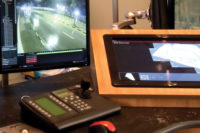Sophisticated software developed by Diebold Enterprise Security, a division of Diebold Inc., North Canton, Ohio, is a critical component of security systems protecting the new World Trade Center currently under construction in New York City. When completed several years from now, the new World Trade Center will be a cluster of 11 primary buildings and facilities, including five skyscrapers, the third-largest transportation hub in the city, the National Sept. 11 Memorial and Museum, a retail venue, a performing arts center, a vehicle security center and critical infrastructure facilities. Total square footage will run into the millions.
Contracts for the security systems in several individual locations are being awarded separately by the Port Authority of New York and New Jersey, which owns the World Trade Center site. Diebold already has won several of the contracts, as well as the contract to provide perimeter protection during construction. Even more importantly, the integrator was chosen to integrate security and other systems such as elevator and fire alarm systems in multiple buildings through a central command center.
“They wanted a consolidation point so that at a single location, they would be aware of what’s happening at each building,” explains Kevin Engelhardt, vice president and general manager for Diebold Enterprise Security. The project, he says, is “about being able to manage multiple buildings and security applications as well as multiple other facets of each individual site.”
The Port Authority’s review process for the software integration contract took about six months. Engelhardt believes Diebold won the contract because of its broad talent base. “What differentiated us was that we could understand the hardware and software applications around the entire site,” Engelhardt says.
Diverse systems integrated
A critical element of the project was to integrate software from multiple systems — for example “pulling data from an elevator or video system so that when it comes to a single system, it’s managed uniformly,” Engelhardt explains. The software platform also will integrate what Engelhardt calls “best of breed” software such as identity credential and access management systems, intrusion and fire alarms, building management systems; vertical transportation; digital intercom; radio communication; chemical, biological, radiological and nuclear (CBRN) systems; and vehicle scheduling and management systems.
The software integration process involved “extremely heavy lifting,” observes Engelhardt. Diebold acts as the general contractor on the jobs it has won, working closely with key suppliers Quantum Secure and VidSys. “It was an all-hands-on-deck, team spirited type of approach,” comments Engelhardt.
VidSys is a provider of Physical Security Information Management (PSIM) software and Quantum offers Physical Identity and Access Management (PIAM) software. Together the two software platforms will serve as the basis of what Diebold is calling a Situational Awareness Platform Software (SAPS).
One key challenge that Diebold had to overcome was reluctance on the part of system vendors to share information about their systems so that the systems could be effectively integrated. Initially some vendors were concerned that information they shared might find its way into the hands of competitors. “But once we were able to speak on an IT-centric level, their guard came down,” recalls Engelhardt. “Once they understood the magnitude and importance of this project, they got on board.”
To help ensure that the SAPS platform would be ready by the promised date, Diebold built two separate solutions in two separate locations. Using that approach, Engelhardt explains, “We could do our work way in advance and try to determine problems and solutions. It really helped minimize potholes.”
Police and fire department officials were closely involved in security system planning from the beginning of the process. “We’ve been walking them through demonstrations,” comments Engelhardt. “They understood the value of the application and how it would support their needs.”
Decisions about how to handle various potential events are “being made in advance in a controlled environment,” Engelhardt says. “When an event occurs, the reaction will be predetermined and pre-vetted.”
Moving forward
A key advantage of the integrated software approach that Diebold is using is that when new technologies come on board, the client won’t have to replace existing solutions, explains Engelhardt. “Once something is tied in, it’s always tied in,” he says. “If a new technology comes in, it will be communicated back to the older platform. It’s a great way to leverage capex without being caught in a proprietary stranglehold.”
Future plans for the SAPS system include connections to variable signs, mass notification software and vehicle screening software.
Security for the transportation hub was also a major win for Diebold. The hub, targeted to open in 2014, is expected to serve more than 250,000 travelers each day. Among other things, Diebold’s work will include installing access control points that will use secure credentials as well as biometrics to identify and grant access to employees, contractors and security personnel.
Diebold’s integrated surveillance system will enable the Port Authority to monitor entrances, exits, rail platforms and other pedestrian zones, as well as high-priority areas such as electrical and telecommunication rooms.
| PROJECTS in the News |
|
Brooke Army Medical Center, a U.S. Army Hospital and Level 1 Trauma Center in Texas, is upgrading and expanding its video surveillance capabilities with NiceVision Net 2.0 from NICE Systems to secure new facilities including a new seven-story hospital wing and an adjoining 5,000-space multi-level parking garage. The solution will integrate more than 1,600 video surveillance cameras.
NICE Systems describes itself as a provider of intent-based solutions that capture and analyze interactions and transactions in real time to extract and leverage insights. Net 2.0 is an IP-based video solution that will enable BAMC to leverage its existing infrastructure of analog surveillance cameras while migrating to IP video, NICE Systems says. One specific need for BAMC is to capture high-quality images of vehicles entering its new parking structure along with associated license plates so BAMC can instantly recall video by license plate numbers. To address this need NICE is providing a video surveillance/ license plate recognition solution. ■ ■ ■
Pasadena Refining System, a refiner and marketer of petroleum products, deployed the PIVCheck Plus Desktop Software from Codebench to register TWICs into their physical access control system, as well as OMNICheck Plus Mobile Software, a mobile validation software application that verifies PIV, TWIC, FRAC, CAC and DESFire credentials. With PIVCheck Plus, the refinery is able to read, validate, authenticate and register TWIC cards into the facility’s Symmetry physical access control system from AMAG Technology. “We’re being proactive with our TWIC usage at our facilities,” said Eric Finck, security supervisor at Pasadena Refining Systems. “To check the revocation status of a card, you have to automate the process and OMNICheck provides that solution.” Codebench is a provider of TWIC/HSPD-12/FIPS-201 authentication and physical access control middleware. ■
Supercircuits advised Goodwill Industries of Silicon Valley about an IP video camera system aimed at minimizing theft in GWSV’s 15 retail outlets and in its warehouse. GWSV chose the SC Black NVR and indoor 1.3 megapixel IP dome security cameras. According to Supercircuits, the cameras provide super high-resolution images and allow users to digitally zoom in on specific details with greater clarity and integrity while reviewing video. “We are very happy with the new IP system because not only was it easy to install, it has an extremely user-friendly interface,” said Nandor Fejer, security manager for GWSV. “The increased resolution is exactly what we need to prevent employee theft and monitor productivity. With the IP system our installation time and costs have been cut in half.”
The city of Aurora, Colorado deployed the DVTel Latitude Network Video Management System to improve the safety and security of the city’s court and jail complex. The system includes 286 cameras. “We have focused on monitoring live video,” said Bryan Verhoeff, the Court IT staff member in charge of the DVTel video management system. “We have a monitor displaying several camera views as people come through the metal detector at the entrance. This serves as a great deterrent.” On the jail side, Vehoeff said, “we’ve had an increasing number of requests for video footage to use in investigations,” adding “the system is proving to be both a good deterrent and a good investigative tool.” ■ ■ ■
An updated fire protection system on the Miles College campus in Alabama uses the MS-9600UDLS addressable fire alarm system from Fire-Lite Alarms. The system uses an existing IP network for fire alarm reporting to a central station operated by fire alarm and security integrator Protection 1, thereby eliminating the cost of two phone lines per system. The central station is backed up by four additional UL listed fully redundant monitoring systems. Protection 1 also installed the new system, which involved four buildings on campus. Each building got its own panel. In addition, the system included 41 new pull stations, 79 addressable smoke detectors, 22 addressable duct detectors and 67 strobe lights. Edward Jenkins, Miles College physical plant director, said he is impressed with the fire alarm’s immediate notification capability and Protection 1’s same-day service. “We are really pleased with our experience, not to mention the great service,” said Jenkins.
When an environmental health and safety company in Carlsbad, Calif., changed locations to a new, large commercial building, it redesigned the top floor of the two-story, 75,000 square foot building it was relocating to with high-performance structured cabling system from ICC, La Mirada, Calif. The end user cited the importance of having a reliable network infrastructure to protect large amounts of health and safety compliance-related data. The company chose cabling experts, River Fire & Security, San Diego, an ICC Certified Elite installer and a licensed fire and security contractor. The new project required an end-to-end CAT 6 data cabling system to support multi-user computers and an Avaya telephone system. ICC’s CAT 6 modular connectors, patch panels and premise cables are specifically tuned together for the best possible permanent-link performance and exceed the TIA-568-C.2 standard when installed end-to-end. Three distribution racks mounted with ICC’s newly designed CAT 6 patch panels were installed in the equipment room. More than 100,000 feet of ICC CAT 6 premise cables were pulled and routed from the equipment room and dropped to all work areas. River Fire verified the entire system with a manufacturer lifetime warranty. For information, visit www.icc.com. ■ ■ ■
HID Global, Irvine, Calif., announced that the company’s credential and reader solutions for access control were selected by mutual insurance company EMC to protect its entire, multi-structure corporate campus at the company’s headquarters in Des Moines and an additional facility in Ames, Iowa. EMC worked with a security systems integrator to design a comprehensive solution for protecting seven buildings, two parking lots and one parking structure. Its existing, 15-year-old access-control system infrastructure was based on proprietary technology that was no longer supported by the manufacturer, making it impossible to expand while leaving EMC vulnerable to security risks. “We were in dire need of an upgrade in order to perform the functions we required,” said Scott Gooch, control center supervisor with EMC. “Now, with our integrated solution from HID Global, we’ve not only eliminated critical immediate risks that could have been extremely costly, but also have the flexibility to continue upgrading our system as our needs change and security threats evolve. We also plan to expand the HID solution to our 17 branch offices across the country, from Providence, R.I. to Phoenix.” NICE Systems Ltd., Ra’anana, Israel, announced that AeroExpress, a provider of rail transportation services between Moscow’s rail terminals and its three airports, will implement NICE Situator to improve overall security operations. AeroExpress will also be implementing NiceVision Net, NICE’s enterprise-class, open-platform IP-based video surveillance solution along with video analytics capabilities for automatic intrusion detection. The NICE solutions will enable AeroExpress to effectively manage security situations and respond quickly to events as they occur. ■ ■ ■
Charles M. Schulz Sonoma County Airport in Sonoma County, Calif., chose Symmetry Security Management System (SMS) from AMAG Technology, Torrance, Calif., to upgrade its current security system and secure its newly expanded airport terminal. AMAG Technology, an access control, IP video and intrusion detection solution provider, along with Electronic Innovations, an automatic entry and security management company, worked together to upgrade the current security system and to provide the newly renovated terminal with a security solution. The system monitors and controls access to the airfield, terminal and other private areas via Symmetry’s ID badging. Twelve remote gates will be tied wirelessly to the Symmetry SMS that includes approximately 60 HID RK40 readers. ■ ■ ■
Avigilon, Vancouver, Canada, a provider of high definition (HD) and megapixel video surveillance solutions, announced that Rogers Centre, a 50,000 seat capacity multi-purpose sports and entertainment venue and home to the Toronto Blue Jays in Toronto, Canada, deployed the Avigilon HD Surveillance System. Rogers Centre deployed a security plan that is flexible and readily adaptable to meet the needs of any event—ranging from 5,000 visitors at a tradeshow to 50,000 during a Blue Jays Major League Baseball game. “Because we host a range of events with different configurations, we wanted a powerful, flexible, and cost-effective surveillance solution—one that could give us access to information needed to make staffing decisions and review incidents more successfully to better serve our customers,” said Mario Coutinho, vice president of stadium operations and security at Rogers Centre. “The Avigilon HD surveillance system provides us with superior clarity, maximum coverage and ease of management—key features we needed to enhance our incident management capabilities at all events.” Nineteen Avigilon HD 16MP cameras cover the entire seating bowl while a mix of Avigilon HD 1MP, 2MP, 5MP, 11MP, and 16MP cameras monitor the building’s exterior. Three Avigilon HD network video recorders (NVR) store continuous surveillance footage.
|










